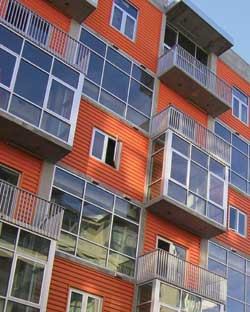Specifically, more high-rise buildings today feature balconies that are cantilevered–where they’re open on three sides–rather than embedded balconies, says Judd Bobilin, senior vice president of development for Atlanta-based Novare Group, which currently has more than 3,500 condo units under development in Atlanta, Nashville, Tenn., Tampa, Fla., and Charlotte, N.C. “Although people don’t tend to use balconies as much as a porch on a single-family home, they’re a necessity for high-rise residential,” he says.
Moreover, balconies are another place in residential towers where glass is being used. And, although glass is more expensive than masonry, it allows for edgier design. “Developers are using glass in different shapes today to create an entirely different visual appearance,” Loewenberg says. “Glass is more fluid and allows you to cant things at goofy angles, particularly roofs and balconies.”
Hamilton agrees: “Today’s high-rises are almost like sculptures–with a lot of curves in the building’s skin. We’re trying to break away from one large mass.”
Mixing It Up
While most new residential high-rises incorporate a large amount of glass in their faÇades, developers also are mixing in other materials in an effort to make their buildings more eclectic and, at the same time, help them fit into the existing landscape.
“I think there was a period when residential buildings tended to look the same, but now people want to be distinctive,” AvalonBay’s Harris says. “Developers are making a conscious effort to be a little more unique, and the driver is from the for-sale market.” He points to Avalon Chrystie Place as an example of a high-rise that incorporates a variety of materials. Designed by Miami-based Arquitectonica, Avalon Chrystie Place’s skin is comprised of several colors of brick and glass.
Design experts agree that using a variety of materials in a single project creates more visual interest. “The main thing is that we don’t want everything to look the same,” Loewenberg says. “To have everything all the same material is too sterile.”
In particular, consumers are attracted to projects where construction materials are exposed, giving the buildings an edgier, raw feel. This type of design treatment also allows developers to save some money by using structural elements as part of the building’s skin, says Daun St. Amand, vice president of Baltimore-based RTKL Associates.
For example, the pre-cast concrete used for the 18-story Acqua Vista in San Diego‘s Little Italy neighborhood serves two purposes–it acts as an exoskeleton for tower and the exposed concrete also provides the faÇade treatment, according to St. Amand.
